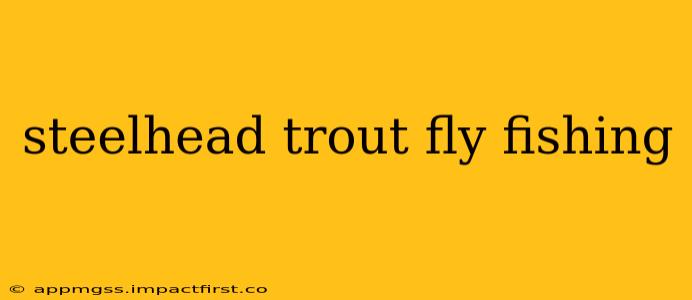Steelhead trout, the ocean-going rainbow trout, are renowned for their power, beauty, and challenging nature. Fly fishing for these magnificent creatures is a pursuit that captivates anglers worldwide. This comprehensive guide delves into the intricacies of steelhead fly fishing, providing insights into techniques, tackle, and strategies to enhance your success on the water.
Understanding Steelhead Behavior
Before you even think about casting a line, understanding steelhead behavior is crucial. These fish are highly intelligent and adaptable, requiring a nuanced approach. Their behavior is influenced heavily by water temperature, river flow, and the time of year. Knowing when and where they hold in the river system is half the battle.
What are the best times of year to fly fish for steelhead?
Steelhead runs vary significantly based on geographic location and specific river systems. Generally, the fall and winter months see strong runs in many areas, but some rivers also have significant spring and summer runs. Consult local fishing reports and regulations for your target area to determine the optimal fishing periods. Knowing the specific run timing is essential for maximizing your chances of success.
What are the best times of day to fly fish for steelhead?
Steelhead can be active throughout the day, but often feed most aggressively during periods of low light—dawn and dusk. However, overcast days or periods of rain can stimulate feeding activity throughout the day. Flexibility and persistence are key.
Essential Gear for Steelhead Fly Fishing
Choosing the right gear is paramount for success in this demanding pursuit. Steelhead are powerful fighters, necessitating durable and reliable equipment.
What type of fly rod is best for steelhead?
A 9-foot, 7-weight fly rod is a popular choice for steelhead fly fishing, offering a good balance of power and sensitivity. However, the optimal rod length and weight will depend on the size of the river and the size of flies you'll be using. Lighter rods (5-6 weight) are suitable for smaller rivers and lighter flies, while heavier rods (8-10 weight) are more appropriate for larger rivers and larger flies.
What type of fly reel is best for steelhead?
A large arbor fly reel is recommended for steelhead fishing to facilitate quick line retrieval and minimize fatigue during long fights. Look for a reel with a strong drag system capable of handling the powerful runs of a steelhead. Proper line management is critical, and the reel plays a significant role.
What type of fly line is best for steelhead?
A weight-forward floating fly line is a standard choice for steelhead fishing, providing good casting distance and control. However, sinking lines (such as sink-tip or full-sinking lines) can be very effective in deeper runs or during periods of high water. The choice of line will depend on water conditions and the depth you need to reach.
Essential Steelhead Flies
Selecting the appropriate fly patterns is crucial for attracting steelhead. A variety of flies can be effective, and your success will often depend on understanding local preferences.
What are the best fly patterns for steelhead?
Steelhead flies range from small nymphs and eggs to larger streamers and swung flies. Popular patterns include various variations of egg patterns, woolly buggers, intruders, and other brightly colored streamers mimicking baitfish. Experimentation is key; what works in one river system may not work in another.
Techniques for Steelhead Fly Fishing
Steelhead fly fishing employs various techniques, each with its own advantages and challenges.
What are the best techniques for steelhead fly fishing?
The most common techniques include:
-
Swinging: This involves letting the fly drift naturally downstream, allowing the current to work its magic. This technique is particularly effective in deeper pools and runs.
-
Dead-drifting: This involves presenting the fly to the fish in a natural and unhurried manner, imitating a drifting nymph or insect.
-
Inducting: This technique involves using a variety of casts and retrieves to entice a strike, often focusing on areas where steelhead are likely to be holding.
Conclusion
Steelhead fly fishing is a challenging but rewarding pursuit. By understanding steelhead behavior, selecting the right gear, choosing effective flies, and mastering various techniques, you can significantly increase your chances of success. Remember to check local regulations and practice responsible fishing to help preserve these magnificent fish for future generations. Tight lines!
